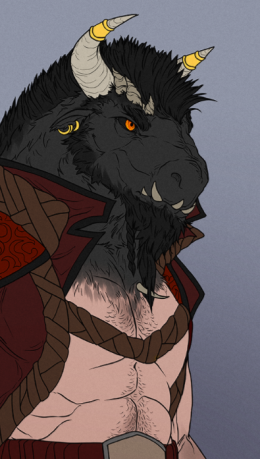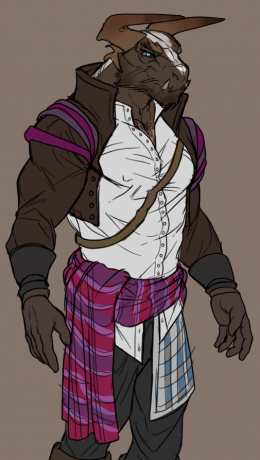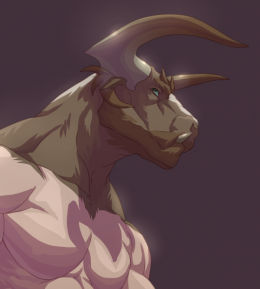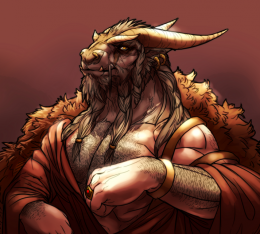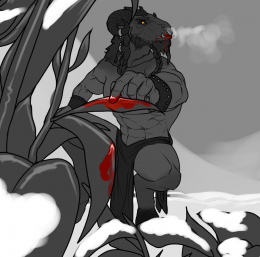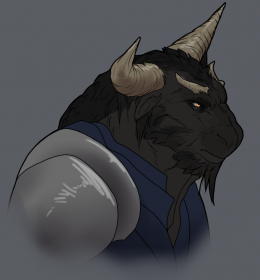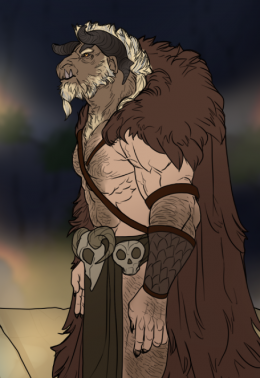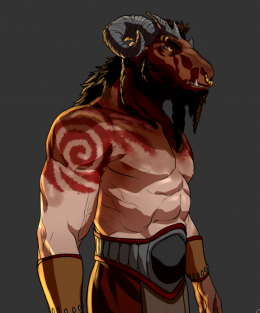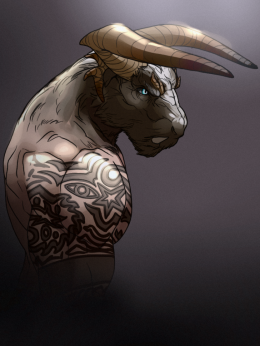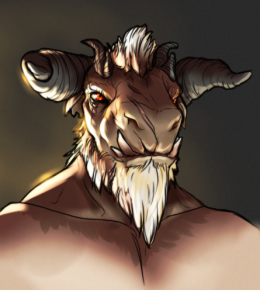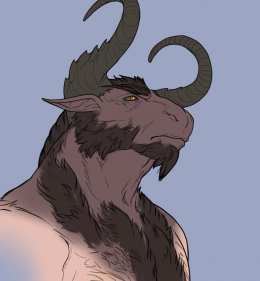Urlan: Difference between revisions
mNo edit summary |
mNo edit summary |
||
| Line 48: | Line 48: | ||
| Verdant Urlan | | Verdant Urlan | ||
| Green with specks of white and green, with dark-gray eye-whites. | | Green with specks of white and green, with dark-gray eye-whites. | ||
| Skin color based on the prior Yanar skin color, with potential for the growth of patches of moss, lichen, and occasional flowers. The Verdant | | Skin color based on the prior Yanar skin color, with potential for the growth of patches of moss, lichen, and occasional flowers. The Verdant Urlan have a fur-like moss or grass texture on the spots where fur would be. Instead of normal top hair, they may also have vines growing, or retain normal hair. Ears also appear less bovine and more Nelfin-like pointed. Horns may also be made of wood-like or antler-like branches. | ||
|- | |- | ||
| style="background-color:#decdbd;" | Allar, Slizzar | | style="background-color:#decdbd;" | Allar, Slizzar | ||
| Line 99: | Line 99: | ||
*Thron-Saraak is a term used to describe an Urlan who commands a Throng, comparable to a chief for the Throng. | *Thron-Saraak is a term used to describe an Urlan who commands a Throng, comparable to a chief for the Throng. | ||
*Hertok is a term used by Urlan to define cleansing themselves of any disdain of a particular person. | *Hertok is a term used by Urlan to define cleansing themselves of any disdain of a particular person. | ||
*Wartaal is a term used by Urlan to define a specific | *Wartaal is a term used by Urlan to define a specific Urlan as a mentor. This is more personal than Rentar-Saak-Utar. | ||
*Tarlok-Vheer is a term used to describe a honor duel between two Urlan, which can also be used to settle a dispute. | *Tarlok-Vheer is a term used to describe a honor duel between two Urlan, which can also be used to settle a dispute. | ||
*Rektaal is a term used by the Urlan that is defined as “enemy”. This is generally used to deject those marked as enemies of Throngs. | *Rektaal is a term used by the Urlan that is defined as “enemy”. This is generally used to deject those marked as enemies of Throngs. | ||
Revision as of 23:47, 18 April 2022
| Urlan | |
|---|---|
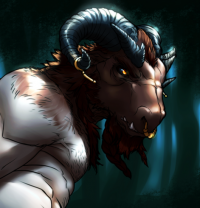 | |
| Race | |
| Pronunciation | Earl-an |
| Classification | Gorr |
| Subraces | None |
| Common Nicknames |
|
| Languages | Race dependent, though they also speak Oortaal |
| Naming Customs | Race-dependent |
| Racial Traits | |
| Distinctions | Symbiotic beast-men hunters |
| Maximum Age | Symbiosis halts aging and adds another 100 years on top of life expectancy. |
| Height | 6’5 to 7’0 |
| Weight | 220 to 400 lbs |
| Eye Colors | Varies |
| Hair Colors | Brown, black, blond, rust brown, never bright colors |
| Skin Tones | Depending on host Race, natural, but decolored |
From the far north stampede the Urlan, a Race of beast-men that roam the wilds, lording over all manner of beasts and creatures with their unrivaled hunting skills. Urlan are a relatively rare sight, and much of their existence remains a mystery to many, including how they increase their ranks by forcing or granting symbiosis on willing and unwilling hosts. Many regions in Jorrhildr have been declared off-limits, as the Urlan Throngs roam these lands and rule them, smashing any military force sent to try and compete them out. Some, however, wander to Regalia, called by adventure, or to settle to eternal struggle in their mind where they are torn between their beastly wild mind, and their old life. With great physical prowess and a stoic demeanor, Urlan are seen as the most stalwart and strong warriors, able to rival the Eronidas shocktroopers of the Regalian Empire. Any self-respecting hunting guild contains at least a few Urlans, and Urlan have also become a staple in the Regalian Military due to the inclusion of the Urlan Legion under the previous Emperor Cedromar I. One of the fastest-growing Races in Aloria, the Urlan have yet to find their place in the world, whether to embrace the call of the savage wilds or to try and hold onto their old lives. And yet some claim to have found a new way, merging both the past and the future together into a much stronger whole.
Physical & Mental Characteristics
To call Urlan a Race is not exactly right. While all other Races are born from two people of that Race reproducing, most Urlan are actually made through a process of Symbiosis, where an Oorl Worm invades (or is invited) into a host, and merges with the body to change it. Urlan appearance may as such vary, as visual aspects of the original person are adopted into what the Urlan eventually looks like. There are some common traits however that allow the Urlan usually be recognized. The best way to describe them is as humanoid half-bull-people, with the upper body of a humanoid, the head of a bull or deer-like beast, and the lower legs of such a beast also. There exist three distinct Clades of Urlan, the Northern Clade dominant in Jorrhildr and Ellador and all surrounding lands, the Midlands Clade dominant in Essalonia and the Regalian Archipelago and in between, while the Warmland Clade is active mostly in the north of Ithania and Nordskag. The Northern Clade Urlan have heads shaped like those of Wild Cattle, Bison, or Buffalos, while Midlands Clade Urlan have heads shaped like those of Elk, Megatherium, Deer or Ancylotherium. Finally, the Warmland Clade have heads shaped like Woolly (domestic) Sheep, Goats, Ibex, Mouflon, and Argali. Additionally, Urlan can be divided based on what Race they were prior. If an Urlan was the result of a Symbiosis between Ailor, Sihai, Qadir, Songaskia, Altalar, Dwarf, Cielothar, Avanthar, Isldar, Kathar or Maraya, then they default to the Vitality Urlan, the most common Urlan type. Vitality Urlan set the default standard for all other types, with a beast-like head and two large horns (and potentially smaller bones along the brow-bone), fur that extends down to the shoulders and chest, and bovine lower legs with some variety. It is however also possible for an Urlan to accept a more bestial nature of themselves, and for the fur to cover more parts, or even their entire body. There exist also other types of Urlan however: Brandor Urlan that are created from a Symbiosis by Eronidas, Bested Urlan from Asha, Scaled Urlan from Slizzar and Allar, and Verdant Urlan that are created from Symbiosis with a Yanar, or Symbiosis with any Race but with an Oorl Worm that can only be found in a Garden of Vol, tended to by a Cult of Vol. Below is a table that shortly summarizes the differences per Race depending on the Symbiosis gained from different Races.
| Race | Urlan Term | Eye-Color | Description |
|---|---|---|---|
| Ailor, Sihai, Qadir, Songaskia, Altalar, Avanthar, Isldar, Kathar, Maraya, Dwarf, Cielothar | Vitality Urlan | Orange with specks of red and yellow, with dark-gray eye-whites. | Default Urlan appearance. Skin color is inherited from the original body and slightly darkened, while hair color is inherited and becomes the fur color, with additional fur discolorations and patterns possible. |
| Yanar, or Symbiosis on any Race but with a Oorl Worm from a Garden of Vol (see Cult of Order) | Verdant Urlan | Green with specks of white and green, with dark-gray eye-whites. | Skin color based on the prior Yanar skin color, with potential for the growth of patches of moss, lichen, and occasional flowers. The Verdant Urlan have a fur-like moss or grass texture on the spots where fur would be. Instead of normal top hair, they may also have vines growing, or retain normal hair. Ears also appear less bovine and more Nelfin-like pointed. Horns may also be made of wood-like or antler-like branches. |
| Allar, Slizzar | Scaled Urlan | Yellow with specks of green and orange, with dark-gray eye-whites. | Black (if Slizzar) or original scale (if Allar) scales where humanoid skin would be for Vitality Urlan (but still have fur where all Urlan also have fur). Additionally, Scaled Urlan have a forked tongue, slitted eye pupils, and instead of top-head hair they may have medusa-like snakes, or just normal fur-hair. |
| Asha | Bested Urlan | Orange with specks of red and yellow, with dark-gray eye-whites. | Instead of humanoid skin that Vitality Urlan would have, their entire body is covered in fur. Instead of an optional tail from Symbiosis II, they permanently keep their Asha tail. Instead of hooved feet, they are Asha-like feet with claws. Bested Urlan never have tusks, they always have sabre teeth. |
| Eronidas | Brandor Urlan | Orange with specks of red and yellow, with dark-gray eye-whites. | Skin color is inherited from the original body and slightly darkened. Brandor Urlan can never have sabre teeth, they must always have at least one set of protruding tusks. Brandor Urlan in general have more exaggerated tusks than other Urlan types that may sometimes even curl. |
| Half-Races | - | - | Pick one of the parents, then choose the corresponding Urlan Type above. |
Urlan Personalities
Urlan personalities have some room for variation because not all Urlan properly mentally integrate with the Oorl Worm after Symbiosis, but some traits are shared. Primarily, Urlan are stoic giants who feel and perceive a lot, but so not express their emotions outwardly at all. They speak very little, and use body language more frequently to communicate, but are also very sensitive (if they want to be) to the feelings and emotions of others, even if one can go through their whole life never seeing an Urlan expressing a single emotion, which they consider a private matter. Urlan, unlike Slizzar however, do not intend to use the information gained from this natural Empathy, but rather use it to better understand the position or rhetoric a person is making, or to be a good mentor for someone who struggles with inner demons. Indeed, Urlan are so proficient at taking away the pain of others and taking it upon themselves, that Urlan have become a common sight in post-battle medical tents, aiding doctors by accepting the pain of their patients so the medical staff can better tend to the wounds while the Urlan suffers through the agony. Urlan can also be very philosophically inclined as due to their lack of constant dialogue, they have a more calm perception of the world around them, and spend longer time thinking over how to react or respond to something, and the deeper implications of subtext and nuance in their responses. Urlan are generally the kind of beings that would in most cases turn the other cheek, being very aware of their innate strength in comparison to other Races, and generally not wishing harm on others unless pushed into a corner. Urlan can however also have their temper broken, and be unleashed in fits of rage. A great way to aggravate an Urlan to anger is to compare them to simple cattle and call them stupid farm animals. Urlan that have found inner peace are very vain in their appearance, and consider Symbiosis the greatest gift ever bestowed on them in their life. Then there is a small minority of Urlan who have become bitter and angry with the world for rejecting them. This often happens to Urlan who have somewhat accepted themselves as Urlan and found inner peace when it comes to what they are, but also face severe rejection or disgust towards their old life. A good example of this is an Urlan who is happy being Urlan, but is utterly rejected by their family and called a monster and mongrel, or a warrior who finally feels the adrenaline of battle again, but is now disgusted with the weakness and frailty of his former comrades in comparison to himself. These Urlan are Reenhaarn, often forming Throngs that go out of their way to attack other Races purely for not being Urlan, but also don’t Symbiosis anyone they come across unless they take a personal liking to them. Even outside of these common traits, there is a great deal of variance, especially among Ulrof who are unable to console their body and fused Oorl mind with the past. Their personalities tend to be more unstable, with bursts of their old self coming through brighter than they would be if the Oorl’s soothing effect on personality and temper was more constant and stronger.
Symbiosis Process
The act of Symbiosis can occur in two manners, peaceful and hostile. When a person accepts peaceful Symbiosis, they must be aware of what will happen, and be at peace with, or want this decision. It involves cradling the Oorl Worm gently to the exposed chest, after which the Oorl Worm will painlessly merge its way inside, beginning the process of Symbiosis that occurs in a matter of minutes, and proceeds peacefully and painlessly. When it concerns a hostile symbiosis however, an Oorl might feel threatened by the person in its natural habitat, or be forced onto a person by a third party (Urlan or otherwise) by pushing the Oorl Worm against a person’s chest. A hostile symbiosis disregards armor or clothing, whatever obstacle, an Oorl Worm will find its way inside in a painful manner. Then, the Symbiosis process proceeds over the course of several minutes in a painful manner as the host feels all their bones snap and re-mend and their organs rearrange in real time. Either way, when Symbiosis is complete, the Oorl attaches itself to the host’s heart, and continues to live separately from the host but merging minds. Oorl are not exactly people with a full sentient personality, but they do have personality quirks. Generally speaking, Oorl Worms are calm and have a very kind disposition. What this usually does to angry and violent people during Symbiosis, is to temper their rage with stoic control and passiveness. The original personality of the host is not overwritten as such, but rather just nudged into a different direction, not necessarily limited to calming effects however. The Oorl might also embolden the host with a new found pride, vanity, bravery, resolve, stubborn-ness and life-lust. That being said, most freshly made Urlan exist in a very chaotic state of mind for some days or weeks, as they adjust to their new personality and body.
Not all Urlan enjoy Symbiosis after the fact. While there is not a single Urlan or reversed Symbiosis person that cannot deny that Urlanification has absolute physical benefits in terms of lengthening someone’s life-span, returning lost limbs, giving the person greater strength and willpower and generally making them much healthier than their Race could ever be, some Urlan cannot find inner peace or balance between the old life and the new life, and start self-rejecting. When self-rejection occurs, the Oorl can detach from the heart and find whatever way necessary to leave the body, before quickly slipping away while the host’s changes revert in a fairly painless but exhausting process. Oorl rejection can happen at any time, but must only happen a minimum of 5 days after Symbiosis, as the Oorl is not able to detach from the heart before that. Reversed Symbiosis as such can occur a week later, or a month later, or even years later. Some Urlan have even been known to finally reject Symbiosis 30 years after the fact. Urlan sympathize, but don’t always empathize with those that do, and their responses vary radically based on how the person reversed Symbiosis, or who the Urlan is. While rejecting Symbiosis is not an absolute death sentence and reason to hate a person, Urlan do become hostile towards someone who trivializes Symbiosis, ridicules it, or treats Symbiosis like an aesthetic to switch in and out of at leisure, instead of treating it like a major life-changing situation or decision with respect. In some cases, Urlan can even be convinced to help others temporarily be Urlan, even if they would much rather those who undergo Symbiosis stick with it. Urlan who are comfortable post-Symbiosis or have reached a point of balance and peace are called Urlanaan, while those who are in a state of chaos and inner conflict are called Ulrof. Even among Urlanaan and Ulrof, there exist the Baal-Urlan which are Urlan who reject their old life completely and fully immerse themselves into the Urlan Throng life, and Al-Urlan which are Urlan who manage to find a balance between their old life and their new life as an Urlan. Al-Urlan for example retain their old name and dress with enlarged but similar clothing as they did before, while trying to hold onto old customs, while Baal-Urlan dress more like traditional Throng Urlan, adopt a new name or shorten their name, and take on new behavioral quirks.
Symbiosis Possibilities
Symbiosis can be undergone through all manner of different ways. You may write Symbiosis into your Character Application backstory, or acquire Symbiosis IC through a variety of methods. Symbiosis is particular popular among Velheimers and Caeren cultured Ailor, especially those too scarred or wounded by warfare or too frail and old to be of any help to their clans. Urlification is seen as a way to rejuvenate the body and enter a new stage in life, while within Old Gods, Urlification is considered a double-edged knife-gift from the Union of Air. With Regalia, particularly in Vultdragon Unionism (based on Horopadosi sentiments), Symbiosis is seen as one of the acceptable ways to force evolution upon the Ailor Race to better serve the Unionist Spirit. There are also Baal-Urlan Throngs that are very hostile to other Races, engaging in raids particularly in Jorrhildr and Ellador where they raid towns and choose the strongest of those that survive to turn into Urlan while killing the rest. Peaceful Urlan also exist anywhere however, who might always be willing to share on Oorl Worm of themselves, as Oorl Worms create young Oorl Worms inside Urlan hosts that can perform Symbiosis on others when given or forced on them. Furthermore, the Regalian State also has a supply of Oorl Worms available in a habitat somewhere on the isle, which are reserved in particular for saving the lives of soldiers who accept Symbiosis on the field of battle when they are inches away from bleeding to death due to catastrophic internal damage or loss of limb. Finally, there are always those who found what birth gave them insufficient to satisfy their ambitions, hearing tales of the strength and power that Symbiosis brings, thus actively seeking out the Urlan Throngs to convince them to allow them to Symbiosis with an Oorl Worm. Not all these challengers are given what they want, as Urlan tend to be apprehensive to those actively seeking out Symbiosis for power hunger. Urlan that perform peaceful (or hostile) Symbiosis on others usually stay with them while they undergo the process of Symbiosis. This process can both be enlightening, or traumatic, or both, so there is usually a special connection between the person who performed the Symbiosis, and the person who became an Urlan in the process, especially if the Symbiosis was performed with an Oorl Worm from their body. This special connection can vary wildly from a near worship level of deference for granting a gift, to absolutely loathing a person and wishing to violently end their life. Some Urlan that undergo Symbiosis together or at the hands of each other hunt together for life, and try to teach each other new things, mentor to student, and student to mentor. Hunting together is one of the greatest ways for Urlan to bond, especially if it concerns an Urlan showing the ropes of how to be an Urlan to one fresh from Symbiosis. The only time when Symbiosis is not allowed to be implied in Backstory or with NPC Urlans, is if your Character was introduced as non-Urlan in Roleplay/Character Application. If you choose to Urlanify a Character after some time, you have to seek out an actual Urlan in-roleplay to get an Oorl Worm from, or petition the government, or the Vultdragon Celatcy.
Oortaal
Urlan do not have a racial language of their own, but do have a few words that they have learned from the Oorl, who do have a telepathic way of communicating with each other while outside of any potential host. Oortaal is not a formal language, and as such does not require Proficiency points. Every word that exists in this “language” is presented in the bullet point list below, and anyone who learns these terms from an Urlan in roleplay may know them from that point onwards.
- Tokrok are Urlan who force other Urlan through hostile Symbiosis.
- Katrok are Urlan who only perform peaceful Symbiosis and resist Hostile Symbiosis.
- Baal-Urlan are Urlan who believe in rejecting their old lives and the past, and becoming a new person.
- Al-Urlan are Urlan who believe in maintaining the past and letting their old lives be the defining feature of their new.
- Teek-Urlan are Urlan who are born from two Urlan parents as a natural born Urlan.
- Tegh-Urlan are Urlan who are born from Symbiosis in a Hostile manner.
- Aart-Urlan are Urlan who are born from Symbiosis in a Peaceful manner.
- Teel is a term used to describe any non-Urlan. This is generally seen as vulgar or ridiculing. Teeling is also a variant of this.
- Baant is a term used for Urlan outcasts who are expelled by a Throng for crimes against the Throng or Oorl. This is an insult.
- Ehr is a term used to describe the concept of Urlan honor. Urlan have a comparable reverence to honor to Eronidas.
- Tarlok is a term used to describe the Urlan concept of Self-value and Self-respect.
- Rentar-Tarlok-Vheer is a term used to describe an Urlan who has a lot of respect as dignified from their Urlan peers.
- Rentar-Saak-Utar is a term used to describe an Urlan who other Urlan see as a guide or mentor for their inner conflicts.
- Thron-Saraak is a term used to describe an Urlan who commands a Throng, comparable to a chief for the Throng.
- Hertok is a term used by Urlan to define cleansing themselves of any disdain of a particular person.
- Wartaal is a term used by Urlan to define a specific Urlan as a mentor. This is more personal than Rentar-Saak-Utar.
- Tarlok-Vheer is a term used to describe a honor duel between two Urlan, which can also be used to settle a dispute.
- Rektaal is a term used by the Urlan that is defined as “enemy”. This is generally used to deject those marked as enemies of Throngs.
- Reenhaarn is a term used to describe an Urlan who has a seething hatred for their past life or treatment, becoming bitter at the world.
- Urlanaan is a term used to describe a state of being in which an Urlan has found inner peace with themselves and the past.
- Ulrof is a term used to describe a state of being in which an Urlan cannot accept their identity as Urlan and has conflicts mentally.
Summary of Racial Abilities
All Abilities are listed in detail on the Ability List Page. Additional rules applied to those Abilities are recorded in the table below. Aesthetics for Abilities may be dictated by the players, as long as the Ability Name is mentioned in the Emote, which is mandatory for Ability use. The following Abilities are what is considered a Racial Ability Set. Meaning, that none of these Abilities attribute Aberrant status to any individual, even if they are classified like they would. Only additional Abilities gained from outside of this Racial Ability Set can attribute Aberrant Status.
| Ability Name | Ability Type | Ability Range | Ability Description |
|---|---|---|---|
| Omniaware 1 | Constant Passive | Self | Grants the user Omniaware 1 |
| Body Morph 1 | Toggle Passive | Self | Grants the user Body Morph 1 |
| Body Morph 2 | Toggle Passive | Self | Grants the user Body Morph 2 |
| Gate Smash 1 | Trigger Passive | Direct Touch | Grants the user Gate Smash 1 |
| Pure Body 1 | Constant Passive | Self | Grants the user Pure Body 1 |
| Hunt Sense 1 | Toggle Passive | Self | Grants the user Hunt Sense 1 |
| Great Force 1 | Constant Passive | Self | Grants the user Great Force 1 |
| Empath Sense 1 | Trigger Passive | Direct Touch | Grants the user Empath Sense I |
| Empath Sense 2 | Trigger Passive | Emote Distance | Grants the user Empath Sense 2 |
| Empath Sense 3 | Constant Passive | City Wide | Grants the user Empath Sense 3 |
| Empath Sense 4 | Constant Passive | Emote Distance | Grants the user Empath Sense 4 |
| Empath Sense 5 | Constant Passive | Emote Distance | Grants the user Empath Sense 5 |
| Empath Sense 6 | Toggle Passive | Self | Grants the user Empath Sense 6 |
| Symbiosis 1 | Trigger Passive | Direct Touch | Grants the user Symbiosis 1 |
| Symbiosis 2 | Toggle Passive | Self | Grants the user Symbiosis 2 |
History
Urlan history is considerably shorter than that of the other Races, largely because the Urlan are still few in number outside of Jorrhildr. In many ways, they retain their old persona and identity, thus becoming part of the history of their original respective Races unless they choose to become Baal-Urlan. Oorl Worms similarly have a history of barely existing in the world. Some historical references of goat-faced Nelfin existed in the early Allorn Empire, thus creating the impression that Urlan have existed for at least as long as the Elves have. Through the faster spreading of information during the rise of the Regalian Empire however, Urlan have taken a more public role in the world. Despite their legal status though, many still distrusted them. Prior to the education of the masses to the legislation that Justinian introduced, goat faces were often used to identify evil or demon-corrupted Ailor. This in itself was an old folk-tradition based on an Old Gods festival called “The Bleating Man,” a long festival involving consuming goat products with the thematic undertone that goats are probably evil because their bleat is both loud and annoying, and that they stink. While their heads aren’t actually shaped like goats, but rather more like bulls, many Regalians still call them goat-folk as an insult.
In spite of tradition, public opinion is starting to shift due to the changing liberties of other Races, and how valuable Urlan have been to the Empire. Their hunting abilities, their military service, and their far more reserved behavior as well as acknowledge of Ailor customs and culture means they integrate well into society. In fact, many of them don’t need to integrate at all, as they are native to the societies they reside in. The last major event that resulted in nation-wide acceptance of the Race as an (ironically) symbiotic relation between Urlan and Ailor was during the Deathling Crisis in the City of Regalia. When the demonic forces of the Primex roamed the countryside, the Urlan rose to the challenge to fight these wolf-men. Solitary Urlan hunters based in the countryside of the Regalian Crown Isle hunted day and night to capture or slay the wolf-men, keeping Ailor safe. The Urlan were also noted for assisting the rebellion against the Deathling Queen’s control of the city. Their loyalty and support of the state caused public opinion to become very favorable to them, though some still distrust them. Furthermore, while Regalians can support the existence of the Urlan in their society, they still do not welcome Symbiosis and consider it a corruption of body to be feared, even if they won’t say it directly to the Urlan that live among them. While Urlan may only function as footnotes to the histories of the other Races, some notable Urlan have and may one day pass into legend as the most ferocious and skilled hunters. The Urlan residing in the lands from which the Oorl Worm come may yet choose to have a bigger role in the world’s history.
Culture
The vast majority of Urlan exist in Jorrhildr, though some also spread across the world to seek out the thrills of the Nature Hunt, a practice all Urlan engage in, while many also remain part of the societies they originally came from. The Urlan engage in a practice called the Beast Hunt where they target the largest and most dangerous creatures in an attempt to slay them to prove themselves. The reason behind this is unknown. It is speculated that this is a latent desire of the Oorl Worm to experience the thrill of being a predator, thus compelling the fused Urlan to seek out the thrill of the hunt. Urlan frequently showcase their hunts to others, decorating their clothing with skins, furs, teeth and other memorabilia, for both Al-Urlan and Baal-Urlan, though Al-Urlan also combine these trophies with traditionally civilized clothing. Urlan are inherently solitary creatures, though they form relations with people where necessary, and can fall in love with others. Curiously enough, the vast majority of the romantic relationships Urlan engage in, are of their original pre-symbiosis Race. For example, once an Ailor, the Urlan will frequently seek out Ailor partners. Even more curiously enough, Urlan that mate with members of their original Race (or others, where racial interbreeding permits it), can give birth to very normal and healthy individuals that show no sign of Urlan physiology. Urlan are also known to bond with other Urlan (particularly Baal-Urlan) which give birth to Teek-Urlan, less muscular and large Urlan which have a predisposition to be born female.
Urlan in Regalia
Urlan who were once Ailor exist in a rather interesting position in the Regalian Empire, where they remain legal and even enjoy a specific arrangement where their love relations or marriages may continue under the Horned Stipulation, an obscure law that offers Urlans who were once Ailor almost Ailor-like rights for specific services. Urlan who reside in Regalia and live up to the Horned Stipulation (which is only applicable to native Ailor-Urlan) are expected to, much like Eronidas, serve in the Regalian Military, Regalian Guard, or a Noble House Guard. Additionally, these Urlan must present themselves to the Regalian Scholar’s Court whenever necessary to be studied in their physical capacity as well as mental processes, and hand over any and all creatures they have hunted (bar from a trophy tusk or fur) to the Regalian State for further research in dissection and taxidermy. Finally, they are expected not to be public about their relations, and are not allowed to engage in intimacy with anyone in public either, while they are also expected to keep a low profile by avoiding public physical altercations. In this way, Urlan serve a very useful role as mercenary-hunters extraordinaire in Regalia, and enjoy more personal liberties than other Races. They are in fact the only of their kind (an Ailor that is somehow changed to no longer resemble an Ailor) that is accepted by common Ailor people due to their history in the Empire. Urlan who break the laws of the Horned Stipulation are denounced as savages and have their rights stripped.
Urlan Customs and Traditions
Urlan are honorable creatures who prize their own dignity, but also the dignity of others. They become less inclined to pay attention to a person if they see them surrender to degradation or self-loathing and self-pity. They call pride or self-value “Tarlok”, and it is considered “Urtaal”, or dishonorable, to pay attention or respect to anyone who does not have Tarlok. Furthermore, they challenge other Urlan or large Races whom they consider worthy foes to a wrestling duel of honor, a practice called “Tarlok-Vheer”. Urlan consider honor a quantifiable substance that is gained and lost from duels with others, though also something that should be observed. Urlan are more inclined to simply ignore a person if they feel disrespected than to actually attack them, though continued pestering will eventually cause short temper to explode very aggressively. Urlan that have considerably high Tarlok are considered Rentar-Tarlok-Vheer, or masters of the honor duels. These Urlan are treated with much respect by other Urlan, and even members of other Races.
Urlan have curious cultural practices. An Urlan greets another Urlan by roughly yanking their right horn downwards. This is not an attack or an insult, rather it is just the way the Urlan greet each other. If the left horn is yanked instead however, an Urlan disavows another, which may result in a Tarlok-Vheer. While Urlan are quick to anger, their anger towards a person never lasts more than a day. They have a practice called “Hertok” where they mentally cleanse themselves forcibly of disdain towards another person. Hertok can be applied three times to a specific individual before they are declared “Rektaal”, or enemy. At this point, said person should endeavor to hide, as Urlan consider it a possibility to simply eat them to solve the problem of their existence. Urlan family relations are very complicated. A fused Urlan may deny familial relation to their old families, as they are biologically different than one-another. All Urlan, regardless of whether their Symbiosis is forceful or accepted, share a sense of kinship with all other Urlan, though also a form of brotherhood or sisterhood with any Urlan who were involved or nearby during their Symbiosis. This way, Urlan still maintain some sense of family even if the individuals in the Race are barely blood-related to one another, a sentiment more powered by cultural norms than actual logic. Urlan rarely switch Throngs, unless they consider another throng more honorable or dignified, and their current Throng is engaging in dishonor.
Cultures of Al-Urlan and Baal-Urlan
Urlan who remain in their respective societies and try to adapt their old lives to their new physiology and mindset often still form strong bonds with other like minded Urlan in the same area. Urlan in Regalia form Throngs, which can be loosely interpreted to be groups of friends, comrades, or a brotherhood of Urlan where Urlan seek the companionship of other Urlan. This is largely because Urlan, regardless of whether they adapt well within their old society, always feel some need to commune with other Urlan due to a lack of understanding of their new being from their old society. As a result, these Throngs form as quasi-hunting guilds where Urlan frequently gather and discuss either the Beast Hunt or military matters. Alternatively, these meetings also have frequent Tarlok-Vheer or other means of boisterous or masculine behavior. While they are very competitive, the Urlan involved still meet with a camaraderie undertone. Throngs often gather in specific buildings, through open-air Throngs are also frequent, where the Urlan gather once a week in a specific location in the countryside. Occasionally, the Regalian authorities permit the Urlan to use this Throng location as a base to operate from, and engage in limited bear-hunting in the countryside.
Urlan that abandon their old lifestyle often have trouble finding roots elsewhere around the world beyond Jorrhildr. It is not unheard of for an Urlan to become Baal-Urlan and then decide to become Al-Urlan again, though this process is often difficult and requires a lot of outside help from Al-Urlan to complete. Urlan recognize the possibility for other Urlan to become their mentors, a process based on age but also experience where they recognize another Urlan as “Wartaal”, or mentor. As can be evident from the terms above, Urlan have a vocabulary of useful terms to describe situations and individuals, but it does not actually become its own language until they are Baal-Urlan. In spite of different lifestyles, this vocabulary comes naturally to all Urlan. It is theorized that this is based on what Oorl language sounds like, though it doesn’t become commonly spoken until a Baal-Urlan abandons their original heritage, refusing to speak their old language and instead using verbalized Oortaal, the Oorl language. Baal-Urlan also frequently tattoo their own body or cover it in war paint, or at the very least, the blood of their prey.
Primal Baal-Urlan that live among the other Urlan in Jorrhildr are considerably more tribal and savage than Al-Urlan. The Urlan that live there in these communities are loosely bound together by what they call the Horned Throng, a confederate state of various tribes loosely allied. The problem with Urlan society is that it lacks centralized leadership. They all commonly have a vague understanding of what is necessary to move forward in the world, but lack the centralized leadership of other states to achieve it, or even make any steps towards it. There is a semblance of culture, though many would reject it purely because of how otherworldly their customs are. The Urlan, in their natural homeland, barely wear clothes if any, and have only the basest of semblance of civility and etiquette. They unite in warbands that all commonly roam the countryside to create a Throng base, though often venture out alone when the Beast Hunt calls them. Practically every asset of their culture is congested in oral survival of stories of great Beast Hunts, ferocious foes and great deeds by Hero Urlans in their own stories. Urlan often depict these situations in wall paintings drawn from earthen pigments or often also beast blood, painting all over ancient Seraph tombs or abandoned Nelfin outposts. Their purpose no longer survival-driven, the Urlan in these warbands create a strong bond of brotherhood, even if the original hosts or Oorl Worms had no family relations to one another.
Trivia
- Why Urlan heads are shaped like bulls is not known, though many speculate it is because Oorl Worms used Jorrhildr pygmy bovines and goats as hosts before learning that humanoids were better hosts.
- Urlan, when engaged in an honor duel with another Urlan, frequently clash their horns in a wrestle-match. These horns are made of exceptionally tough material that can stop a sword mid-swing and lodge it into the horn. Horns can break off when clashing with other horns, but usually regrow within some months. Horns can be prevented from growing back however by binding the top with a metal cap.
- When an Urlan dies of old age, their heart mutates into a cocoon that eventually bursts and gives birth to a handful of Oorl Worms. These new Oorl Worms are entirely new beings which will then bite their way out of the host corpse and live on.
| ||||||||||||||||||||||
| Accreditation | |||||||||
|---|---|---|---|---|---|---|---|---|---|
|
| ||||||||
